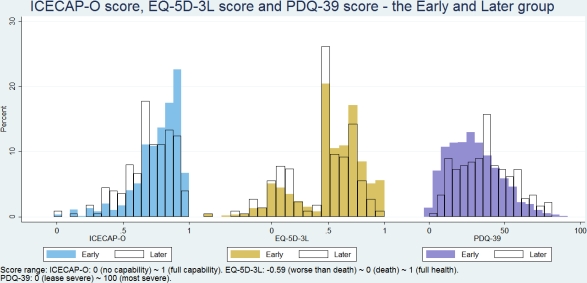Session Information
Date: Monday, June 20, 2016
Session Title: Quality of life/caregiver burden in movement disorders
Session Time: 12:30pm-2:00pm
Location: Exhibit Hall located in Hall B, Level 2
Objective: To test the construct validity of ICECAP-O in Parkinson’s and explore its relationship with the EQ-5D and the PDQ-39.
Background: Parkinson’s significantly affects patients’ health and wellbeing, both of which require accurate measurement and valuation in order to be adequately considered in evaluating treatments and the decision making process for priority setting. In this population, health related quality of life (QoL) can be captured using validated preference-based measures but there is a requirement for a measure which captures wellbeing in a broader sense. The ICECAP-O capability measure was developed with a focus on measuring broader attributes of QoL than health alone in older people for use in economic evaluations. To our knowledge, PD MED is the first study to test the use of ICECAP-O in a Parkinson’s population.
Methods: The ICECAP-O questionnaire, along with the EQ-5D, PDQ-39, demographics and clinical characteristics were collected from 1010 people with early (just initiated on treatment) and 227 with later (adjuvant therapy to levodopa) stage of Parkinson’s in the PD MED trial. We compared these groups and outcome measures using linear and proportional odds regression models and Pearson correlation coefficients, respectively.
Results: The unadjusted mean difference in ICECAP-O between the early and later group was 0.070 (95%CI 0.044, 0.096). Results were similar after adjusting for age and sex: 0.067 (95%CI 0.041, 0.093). The distributions of ICECAP-O score, EQ-5D score and PDQ-39 summary index are shown in Figure 1.  In terms of the ICECAP-O five dimensions, the odds ratios between the two groups (later / early) are 0.71 (95%CI 0.54, 0.93) for attachment, 0.56 (95%CI 0.43, 0.73) for security, 0.52 (95%CI 0.40, 0.69) for role, 0.49 (95%CI 0.38, 0.65) for enjoyment, and 0.46 (95%CI 0.35, 0.59) for control. The ICECAP-O score was found to be highly correlated with EQ-5D score (r = 0.65; p<0.001) and PDQ-39 summary index (r = 0.73; p<0.001).
In terms of the ICECAP-O five dimensions, the odds ratios between the two groups (later / early) are 0.71 (95%CI 0.54, 0.93) for attachment, 0.56 (95%CI 0.43, 0.73) for security, 0.52 (95%CI 0.40, 0.69) for role, 0.49 (95%CI 0.38, 0.65) for enjoyment, and 0.46 (95%CI 0.35, 0.59) for control. The ICECAP-O score was found to be highly correlated with EQ-5D score (r = 0.65; p<0.001) and PDQ-39 summary index (r = 0.73; p<0.001).
Conclusions: The ICECAP-O was able to discriminate between early and later stage of Parkinson’s and was highly correlated with validated QoL measures. ICECAP-O shows potential as a preference-based approach to the measurement of wellbeing in the Parkinson’s population.
To cite this abstract in AMA style:
Y. Xin, J. Lewsey, R. Gray, C.E. Clarke, E. McIntosh. Broadening the evaluative scope of quality of life in Parkinson’s: Testing the construct validity of the ICECAP-O instrument [abstract]. Mov Disord. 2016; 31 (suppl 2). https://www.mdsabstracts.org/abstract/broadening-the-evaluative-scope-of-quality-of-life-in-parkinsons-testing-the-construct-validity-of-the-icecap-o-instrument/. Accessed December 31, 2025.« Back to 2016 International Congress
MDS Abstracts - https://www.mdsabstracts.org/abstract/broadening-the-evaluative-scope-of-quality-of-life-in-parkinsons-testing-the-construct-validity-of-the-icecap-o-instrument/
